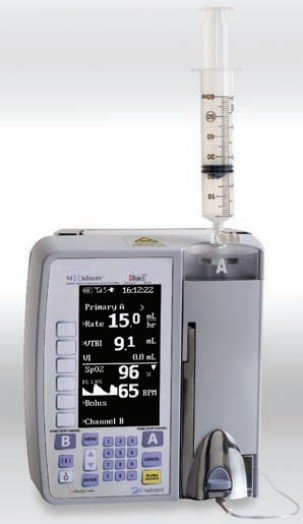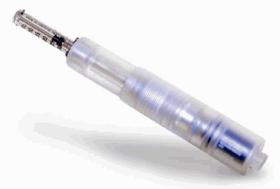 The MRidium 3860+ from IRadimed is the first non-magnetic iv pump with integrated SpO2 monitoring designed specifically for use around MRI scanners. According to the manufacturer: “The new 3860+ offers significantly upgraded performance and features to the already proven MRidium MR IV pump product line. With the addition of a 10 key numeric input keypad and its wider pumping range of O.l mL/Hr to 1400 ml/Hr, the 3860+ series allows quick programming and broad fluid flow control. The drug library has been enhanced to allow user profiles to be stored and easily transferred via the SD memory card to other pumps. With the addition of the Masimo SET Sp02 monitoring and specialized fiber optic sensor, the 3860+ facilitates both safe sedation AND monitoring in one portable MR safe unit. Approved for use in 0.2 to 3 T Magnets. Features: Dose Rate Calculator, Bolus Dose Programming, Secondary Drug Delivery, Syringe Delivery, Adjustable Occlusion Pressure, KVO, SpO2 monitoring, and Alarm Settings, [and] CQI Data Ability w/Tracking Software which records up to 3000 Entries.†A couple of things that stand out, besides being able to use it around an MRI scanner, are the wide range of infusion rates and the ability to use standard 10 to 60 mL syringes with the MRidium Syringe Adapter IV Set (image shown). I’ve seen several pumps that limit users to 999 mL/hr, which can create an issue in certain circumstances. The ability to utilize syringes comes in handy for pediatrics; most pediatric infusions require an entirely different pump.
The MRidium 3860+ from IRadimed is the first non-magnetic iv pump with integrated SpO2 monitoring designed specifically for use around MRI scanners. According to the manufacturer: “The new 3860+ offers significantly upgraded performance and features to the already proven MRidium MR IV pump product line. With the addition of a 10 key numeric input keypad and its wider pumping range of O.l mL/Hr to 1400 ml/Hr, the 3860+ series allows quick programming and broad fluid flow control. The drug library has been enhanced to allow user profiles to be stored and easily transferred via the SD memory card to other pumps. With the addition of the Masimo SET Sp02 monitoring and specialized fiber optic sensor, the 3860+ facilitates both safe sedation AND monitoring in one portable MR safe unit. Approved for use in 0.2 to 3 T Magnets. Features: Dose Rate Calculator, Bolus Dose Programming, Secondary Drug Delivery, Syringe Delivery, Adjustable Occlusion Pressure, KVO, SpO2 monitoring, and Alarm Settings, [and] CQI Data Ability w/Tracking Software which records up to 3000 Entries.†A couple of things that stand out, besides being able to use it around an MRI scanner, are the wide range of infusion rates and the ability to use standard 10 to 60 mL syringes with the MRidium Syringe Adapter IV Set (image shown). I’ve seen several pumps that limit users to 999 mL/hr, which can create an issue in certain circumstances. The ability to utilize syringes comes in handy for pediatrics; most pediatric infusions require an entirely different pump.
Pharmacists aren’t typically interested in infusion pumps, but they catch my eye from time to time since my involvement with the Alaris Smart Pump project at our facility.

